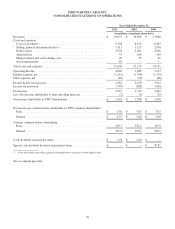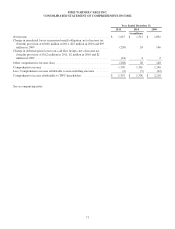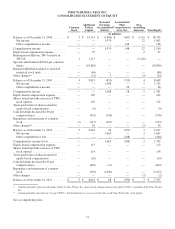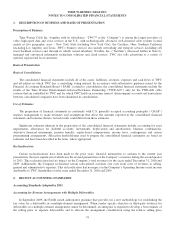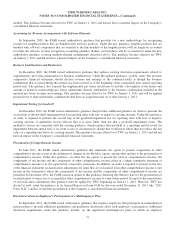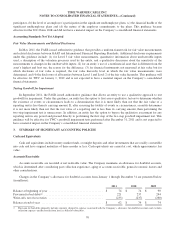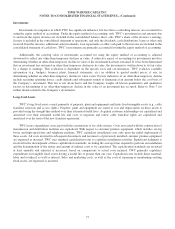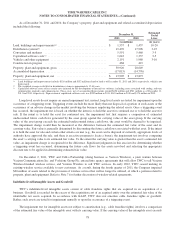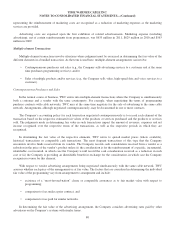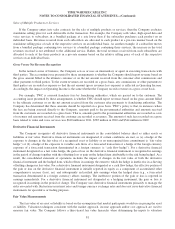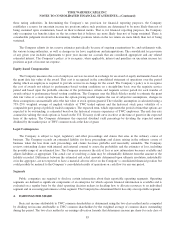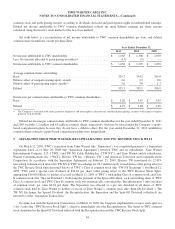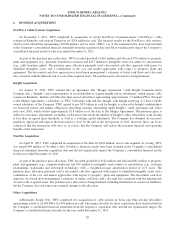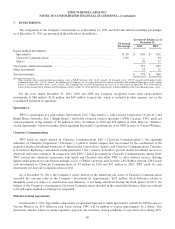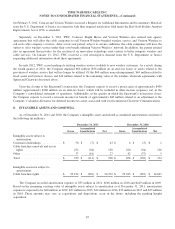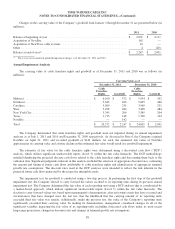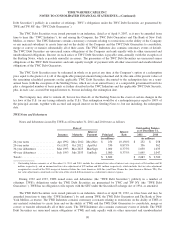Time Warner Cable 2011 Annual Report Download - page 88
Download and view the complete annual report
Please find page 88 of the 2011 Time Warner Cable annual report below. You can navigate through the pages in the report by either clicking on the pages listed below, or by using the keyword search tool below to find specific information within the annual report.TIME WARNER CABLE INC.
NOTES TO CONSOLIDATED FINANCIAL STATEMENTS—(Continued)
representing the reimbursement of marketing costs are recognized as a reduction of marketing expenses as the marketing
services are provided.
Advertising costs are expensed upon the first exhibition of related advertisements. Marketing expense (including
advertising), net of certain reimbursements from programmers, was $635 million in 2011, $629 million in 2010 and $563
million in 2009.
Multiple-element Transactions
Multiple-element transactions involve situations where judgment must be exercised in determining the fair value of the
different elements in a bundled transaction. As the term is used here, multiple-element arrangements can involve:
• Contemporaneous purchases and sales (e.g., the Company sells advertising services to a customer and at the same
time purchases programming services); and/or
• Sales of multiple products and/or services (e.g., the Company sells video, high-speed data and voice services to a
customer).
Contemporaneous Purchases and Sales
In the normal course of business, TWC enters into multiple-element transactions where the Company is simultaneously
both a customer and a vendor with the same counterparty. For example, when negotiating the terms of programming
purchase contracts with cable networks, TWC may at the same time negotiate for the sale of advertising to the same cable
network. Arrangements, although negotiated contemporaneously, may be documented in one or more contracts.
The Company’s accounting policy for each transaction negotiated contemporaneously is to record each element of the
transaction based on the respective estimated fair values of the products or services purchased and the products or services
sold. The judgments made in determining fair value in such transactions impact the amount of revenues, expenses and net
income recognized over the respective terms of the transactions, as well as the respective periods in which they are
recognized.
In determining the fair value of the respective elements, TWC refers to quoted market prices (where available),
historical transactions or comparable cash transactions. The most frequent transactions of this type that the Company
encounters involve funds received from its vendors. The Company records cash consideration received from a vendor as a
reduction in the price of the vendor’s product unless (i) the consideration is for the reimbursement of a specific, incremental,
identifiable cost incurred, in which case the Company would record the cash consideration received as a reduction in such
cost or (ii) the Company is providing an identifiable benefit in exchange for the consideration, in which case the Company
recognizes revenue for this element.
With respect to vendor advertising arrangements being negotiated simultaneously with the same cable network, TWC
assesses whether each piece of the arrangements is at fair value. The factors that are considered in determining the individual
fair value of the programming vary from arrangement to arrangement and include:
• existence of a “most-favored-nation” clause or comparable assurances as to fair market value with respect to
programming;
• comparison to fees under a prior contract; and
• comparison to fees paid for similar networks.
In determining the fair value of the advertising arrangement, the Company considers advertising rates paid by other
advertisers on the Company’s systems with similar terms.
80


